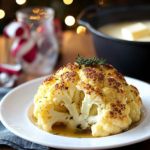Description
This whole roasted cauliflower is crisp on the outside, melting on the inside — Your new favorite way to eat cauliflower! It’s poached first in stock and herbs, then roasted and basted with butter for incredible flavor.
Ingredients
Scale
- 1 medium-large head of cauliflower
- 4 cups (1 liter) low-sodium vegetable or chicken stock (or enough to mostly cover cauliflower in pot)
- Several sprigs fresh thyme, divided
- 2 bay leaves
- 1/3 cup (70g) unsalted butter, melted
- Salt, to taste
- Fresh cracked black pepper, to taste
Instructions
- Prepare Cauliflower: Preheat your oven to 400°F (200°C). Trim the bottom stem of the cauliflower and remove the outer leaves, leaving the head whole and the core intact. Rinse the cauliflower head and pat it dry.
- Simmer Cauliflower: Place the whole cauliflower head in a large pot. Pour in enough vegetable or chicken stock to mostly cover it. Add a few sprigs of fresh thyme and the bay leaves to the stock. Bring the stock to a boil over high heat, then reduce the heat to low, cover the pot, and simmer gently for 12 minutes. This par-cooks the cauliflower.
- Prepare for Roasting: Carefully drain the cauliflower (you can reserve some stock). Transfer the cauliflower head to a cast-iron skillet or another oven-safe pan. Ladle a small amount (about 1/4 cup) of the cooking stock over the cauliflower in the skillet. Drizzle the melted butter evenly over the top of the cauliflower head. Sprinkle with fresh thyme leaves (removed from stems) and season with salt and fresh cracked black pepper.
- Roast: Place the skillet in the preheated oven. Roast for 10-15 minutes, depending on the size of your cauliflower. Baste the cauliflower with the buttery cooking juices from the bottom of the skillet every 5 minutes or so during roasting.
- Check Doneness: The cauliflower is done when it’s tender all the way through and nicely golden brown on top. Check by inserting a sharp knife into the thickest part of the core; it should slide in easily.
- Broil (Optional): For extra color and crispiness, turn the oven to broil for the last 2 minutes of cooking. Watch very carefully to prevent burning.
- Serve: Remove the roasted cauliflower from the oven. Garnish with more fresh thyme leaves, if desired. Carefully slice the cauliflower into wedges or “steaks” and serve immediately, drizzling generously with the buttery cooking juices from the pan.
Notes
- Cauliflower Prep: Trimming the base slightly helps it sit flat, but keep the core intact to hold the head together.
- Simmering: Par-cooking in broth infuses flavor and ensures the inside becomes tender during roasting.
- Roasting Pan: An oven-safe skillet, especially cast iron, works great as it can go from stovetop (if needed) to oven and retains heat well. A baking dish also works.
- Basting: Basting frequently with the pan juices keeps the cauliflower moist and adds flavor.
- Doneness: Cooking time varies with cauliflower size. Use the knife test for tenderness.
- Storage: Store leftover roasted cauliflower in an airtight container in the refrigerator for up to 3 days. Reheat in the oven or microwave.
